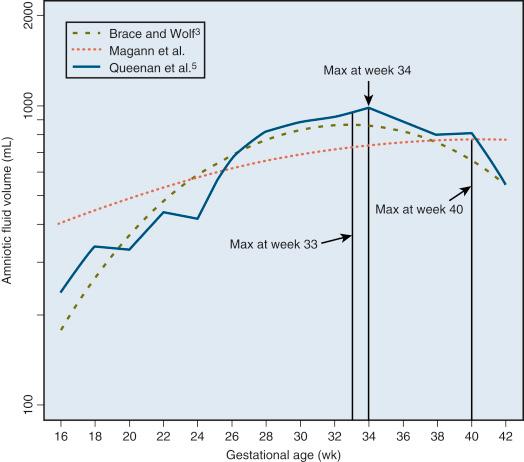Physical Address
304 North Cardinal St.
Dorchester Center, MA 02124
Amniotic fluid (AF) volume is usually well regulated in pregnancy.
Subjective or semiquantitative ultrasound measurement systems are used to identify and categorise disorders of AF volume.
Low (oligohydramnios) or high (polyhydramnios) AF volumes are associated with increased maternal and perinatal complications.
Obstetric management is based on the underlying cause of the abnormal AF volume.
The fetus exists in a fluid-filled environment which assists in pulmonary maturation and musculoskeletal development, provides some protection from infection and trauma, protects the umbilical cord from compression and provides some nutrition. Regulation of the amniotic fluid (AF) volume is not well understood, but aberrations from normal are associated with increased perinatal morbidity and mortality.
Amniotic fluid is 98% to 99% water, with variance in chemical composition with advancing gestation. In early pregnancy, AF is a dialysate of maternal and fetal plasma, with water and solutes traversing the fetal skin bidirectionally. By the second trimester, when the fetal skin keratinises and becomes impermeable to water, the AF becomes increasingly hypotonic and is derived predominantly from fetal urine and lung fluid. AF is removed mainly by fetal swallowing and absorption into fetal blood in the chorionic plate vessels (intramembranous pathway). This dynamic process of AF regulation results in a fairly stable volume of 800 mL from 24 weeks’ gestation until near term, when there is a decline. The precise mechanisms of AF regulation remain uncertain, although the intramembranous pathway is currently believed to be the principal regulator of AF volume.
There are several studies assessing the change in AF volume with increasing gestation. The earlier studies of Queenan and colleagues (1972) and Brace and Wolf (1989) using dye-dilution techniques demonstrated an increase in AF volume from 15 to 20 weeks’ gestation with a maximum volume at 33 to 34 weeks’ gestation. Both these authors demonstrated a progressive decrease in AF volume from the peak until term. A decade later, Magann and colleagues conducted another study in 144 singleton pregnancies using dye-dilution techniques to assess AF volume over gestation in an attempt to overcome some of the methodological problems with the earlier data. Using a growth curve model, Magann and colleagues demonstrated a continued increase in AF volume across gestation, peaking at 40 weeks’ gestation ( Fig. 43.1 ).

Amniotic fluid provides several important functions for fetuses:
The trophic factors found in AF (e.g., insulinlike growth factor, granulocyte colony-stimulating factor), have been postulated to play a role in fetal growth and development.
Protective support permitting fetal growth and movement
Antimicrobial function (e.g., human β-defensins 1–4)
Fetal lung growth
Fetal musculoskeletal development
Maturation of the gastrointestinal system
Research studies of absolute AF volume using dye dilution techniques, radioactive isotopes or direct measurement at hysterotomy, although important for determination of actual fluid volumes, are not applicable for use in the clinical practice setting. Recognising the importance of AF in obstetric outcomes—normal, increased or decreased—the assessment of AF volume for daily clinical practice has centred around ultrasound using either subjective or semiquantitative methodologies. Of the semiquantitative methodologies, only amniotic fluid index (AFI) and maximum vertical pocket (MVP) are in routine clinical practice.
Become a Clinical Tree membership for Full access and enjoy Unlimited articles
If you are a member. Log in here